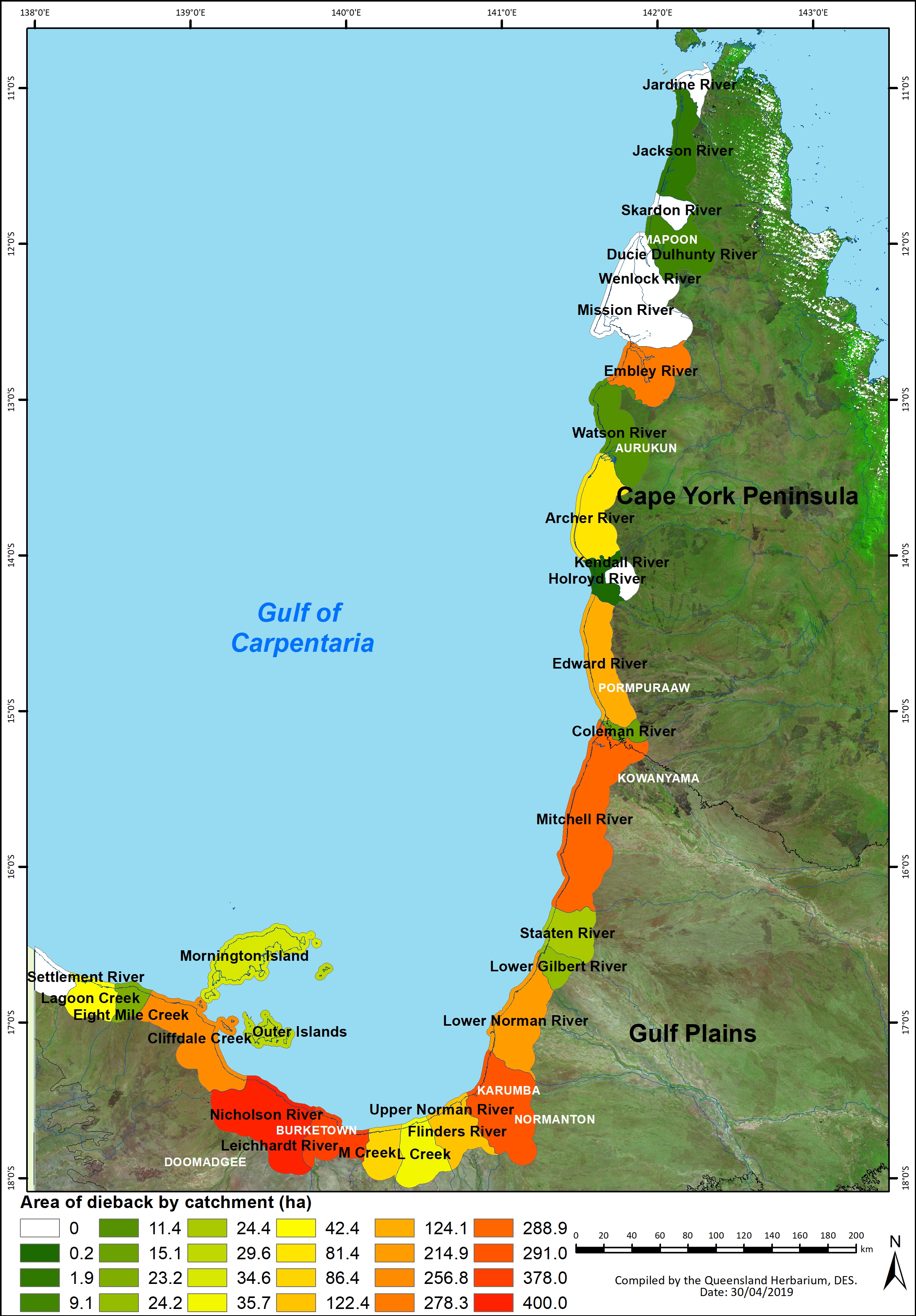|
|
Mangrove dieback in the Gulf of CarpentariaMangrove dieback in the Gulf of Carpentaria was first detected in late 2015 to early 2016 and was reported to impact areas around the Gulf of Carpentaria from Weipa in the north of Cape York Peninsula Queensland to Groote Eylandt, Northern Territory[1][2]. The information provided below and in the Mangrove dieback in the Gulf of Carpentaria Map Story is based on the Mangrove dieback in the Gulf of Carpentaria: baseline for monitoring future trajectory in Queensland report (released 2019) and provides statistical information on mangrove dieback by catchment across the Queensland portion of the Gulf of Carpentaria and establishes a baseline to monitor the trajectory of recovery or decline of the mangrove and associated communities within this area.[1] A program to monitor the future trajectory of the recovery of mangroves and associated communities within the Queensland portion of the Gulf of Carpentaria (from the western tip of the Cape York Peninsula to the Northern Territory border) was established in 2016. This program includes two phases:
For phase one, three monitoring transects were established in the Karumba area in 2017 and five south of the Chapman River, Pormpuraaw in 2018. The information gathered in each transect includes full floristic and structural information following the vegetation mapping methodology using CORVEG sites[3]. Additional structural measurements of tree heights and diameter at breast height (dbh) as well as relative ground surface elevations were also captured. The second phase of the program was the mapping and change detection of mangrove dieback in the Queensland portion of the Gulf using large scale imagery (20 cm) and Lidar captured in August 2017 by Air Research Australia (ARA), and Earth–I 2017 satellite imagery (80 cm) in areas where the higher resolution imagery was not available. The twenty-nine catchments in the study area were analysed, with nine catchments each recording over 100 hectares of dieback with the highest occurring in the Nicholson River Catchment (400 ha). An additional thirteen catchments had mangrove dieback extent from 2 hectares to 86 hectares. In seven of the catchments assessed there was no dieback of mangrove recorded. Each catchment was mapped and was assessed for a number of patch analysis parameters to illustrate the extent and severity of the dieback in each catchment. The mapping has delineated a total of 2774 hectares of dieback with 2295 hectares of mangrove dieback in the Gulf Plains Bioregion and 479 ha of mangrove dieback in the Cape York Peninsula Bioregion. The primary mangrove species impacted by dieback is Avicennia marina subsp. eucalyptifolia (northern grey mangrove). Historical assessment, both in the Karumba and Pormpuraaw areas, illustrates that the mangrove dieback has not discriminated on tree age with deaths occurring in trees as young as six-years old, to trees which were at least 47-years old. The majority of the mangrove dieback area south of Pormpuraaw was open ocean in 1969 with large areas not being colonised by mangroves until after 1998. This reflects the rapid dynamics of mangrove communities and their associated sediments in the Gulf of Carpentaria. See further information about the dieback event, methodology and more by exploring the publication links below:
Additional information
References
Last updated: 17 September 2019 This page should be cited as: Department of Environment, Science and Innovation, Queensland (2019) Mangrove dieback in the Gulf of Carpentaria, WetlandInfo website, accessed 8 May 2025. Available at: https://wetlandinfo.des.qld.gov.au/wetlands/ecology/components/biota/flora/flora-structural/mangroves/mangrove-gulf.html |

 — Department of the Environment, Tourism, Science and Innovation
— Department of the Environment, Tourism, Science and Innovation



